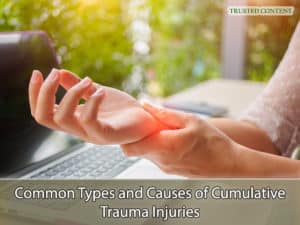Look Out for These Signs of Cumulative Trauma as a Riverside, California Worker

California workers’ compensation laws offer protection to workers who have suffered from injuries or illnesses caused by their jobs. While many workers understand that acute injuries like broken bones are compensable, fewer are aware that cumulative trauma injuries (also known as repetitive motion injuries or repetitive stress injuries) are also covered under workers’ compensation laws. These injuries occur when repetitive tasks over an extended period lead to stress and damage in specific parts of the body. For instance, typing at a computer daily or performing the same repetitive physical movement can gradually damage the tendons, nerves, and muscles.
Cumulative trauma injuries are often subtle in their onset but can have significant long-term consequences if left untreated. They can result in chronic pain, limited mobility, and an inability to perform job duties. Understanding these injuries and their symptoms is crucial for securing the compensation you deserve as a worker in southern California.
California Workers’ Compensation Laws on Cumulative Trauma
California law allows injured workers to seek compensation for medical bills, lost wages, and other losses due to cumulative trauma injuries. The state recognizes that such injuries can have a lasting impact on a worker’s ability to earn a livelihood. However, proving a cumulative trauma injury can be complex, as insurance companies often challenge these claims. Workers must demonstrate that the injury was directly related to repetitive tasks performed on the job over a long period. This can involve collecting medical evidence, work records, and expert testimony to establish the injury’s work-related nature.
One challenge in cumulative trauma cases is the delayed onset of symptoms, making it difficult to pinpoint the exact date of injury. California law addresses this by using the “date of injury” as the date when the worker first knew or should have known that their injury was work-related. This means that even if symptoms appear gradually, workers can still pursue compensation if they act promptly upon recognizing the injury.
Additionally, cumulative trauma injuries are subject to the same workers’ compensation benefits as other work-related injuries, including medical care, temporary disability payments, permanent disability benefits, and vocational rehabilitation. Workers should be aware of their rights and seek legal guidance if their claim is denied.

Common Types and Causes of Cumulative Trauma Injuries
Common Types and Causes of Cumulative Trauma Injuries
Carpal Tunnel Syndrome
This condition affects the hand and wrist due to compression of the median nerve, often caused by repetitive typing, data entry, or other hand movements. The median nerve passes through the carpal tunnel, a narrow passageway in the wrist, and repetitive strain can lead to inflammation and pressure on the nerve. Symptoms include pain, numbness, and tingling in the fingers, particularly the thumb, index, and middle fingers. If left untreated, carpal tunnel syndrome can lead to weakness in the hand and difficulty gripping objects.
Tendinitis
Tendinitis is the inflammation of tendons, the thick cords that attach muscles to bones. It frequently results from repetitive motions involving lifting, reaching, or other similar activities. Workers in occupations requiring repetitive lifting, such as construction or warehouse work, are particularly at risk. Common areas affected include the shoulders, elbows, and wrists. Symptoms of tendinitis include pain, swelling, and tenderness around the affected joint. Early diagnosis and treatment are crucial to prevent the condition from becoming chronic.
Bursitis
Bursitis is the inflammation of the bursa, small fluid-filled sacs that cushion the bones, tendons, and muscles near joints. Bursitis often affects the shoulders, hips, or knees, usually due to repetitive kneeling, squatting, or reaching. For example, construction workers who spend long periods kneeling or painters who frequently reach overhead are at high risk. Symptoms include joint pain, swelling, and stiffness. Severe cases may require medical intervention, such as corticosteroid injections or surgical drainage.
Rotator Cuff Injuries
Rotator cuff injuries involve the muscles and tendons surrounding the shoulder joint. These injuries are typically caused by repetitive overhead lifting or reaching. Workers in professions like painting, carpentry, and warehousing are prone to rotator cuff injuries due to the nature of their repetitive tasks. Symptoms include shoulder pain, especially when lifting the arm or reaching behind the back, weakness in the shoulder, and difficulty sleeping due to discomfort. Treatment options range from physical therapy to surgical repair, depending on the severity of the injury.
Epicondylitis (Tennis Elbow or Golfer’s Elbow)
Epicondylitis is the inflammation of tendons around the elbow due to repetitive gripping, lifting, or twisting motions. Tennis elbow affects the tendons on the outside of the elbow, while golfer’s elbow affects the inside. Workers in manufacturing, plumbing, or mechanics who frequently use hand tools are at increased risk. Symptoms include pain, tenderness, and weakness in the elbow and forearm. Conservative treatments like rest, ice, and physical therapy are often effective, but severe cases may require surgery.
Common Signs and Symptoms of Cumulative Trauma Injuries
Weakness in Affected Muscles/Joints
Repetitive strain can weaken the muscles and joints used frequently in repetitive tasks, leading to decreased strength and difficulty performing everyday activities. For example, workers with tennis elbow may struggle to grip objects, while those with rotator cuff injuries may have difficulty lifting their arm. Muscle weakness can significantly impact a worker’s ability to perform their job duties and reduce their overall quality of life.
Tingling and Numbness
Numbness, tingling, or a pins-and-needles sensation in the affected area may indicate nerve compression due to repetitive motions. For instance, carpal tunnel syndrome can cause numbness and tingling in the fingers, while cubital tunnel syndrome can affect the ring and little fingers. Tingling or numbness should not be ignored, as it can lead to permanent nerve damage if untreated.
Pain and Tenderness
Constant or frequent pain and tenderness in a specific muscle or joint area can be an early sign of cumulative trauma. This pain may initially be mild and occur only during repetitive tasks but can gradually worsen over time. Workers may also notice swelling or inflammation around the affected area. If this pain is associated with repetitive tasks performed at work, seek medical advice promptly to prevent the injury from becoming chronic.
Loss of Motion
Limited range of motion in the affected joint or muscle can signal inflammation, weakness, or other cumulative trauma-related issues. Workers may struggle to move the affected limb fully or experience pain when attempting certain movements. Loss of motion can indicate the injury has progressed and requires immediate medical attention to prevent permanent disability.
Swelling and Inflammation
Swelling or inflammation around the affected joint or muscle is a common sign of cumulative trauma injuries. The body’s inflammatory response aims to protect the injured area, but prolonged inflammation can lead to chronic pain and tissue damage. Swelling may also cause stiffness and limited mobility, making it difficult for workers to complete their tasks comfortably.

Steps to Take After Noticing Symptoms of Cumulative Trauma
Steps to Take After Noticing Symptoms of Cumulative Trauma
Seek Immediate Medical Attention
If you notice any of the above symptoms, consult a doctor promptly to prevent further injury and obtain a proper diagnosis. Delaying medical care can lead to the injury worsening and potentially becoming permanent. A healthcare professional can provide a thorough evaluation, recommend appropriate treatment, and document the injury’s work-related nature for your workers’ compensation claim.
Report the Injury to Your Employer
Notify your employer about the injury and document the repetitive tasks associated with your work. This step is crucial, as failure to report the injury promptly (within 30 days) may result in denial of your workers’ compensation claim. Make sure to submit the injury report in writing and keep a copy for your records. Your employer is then responsible for providing you with a claim form and instructions on how to proceed.
Document the Injury and Work-Related Tasks
Keep detailed records of your injury, the repetitive motions that contributed to it, and any medical treatments received. Include notes on when you first noticed symptoms, how they have progressed, and how your job duties relate to the injury. Collect any relevant work schedules, task lists, or equipment usage logs that demonstrate the repetitive nature of your work. These records will help substantiate your claim and increase your chances of securing compensation.
Consult a Medical Professional for an Accurate Diagnosis
A medical professional can provide an accurate diagnosis and establish a connection between your cumulative trauma injury and work-related tasks. This diagnosis is essential in proving your eligibility for workers’ compensation benefits. Make sure to follow your doctor’s treatment plan and attend all follow-up appointments to show that you are actively seeking recovery.
How Napolin Accident Injury Lawyer Can Help with Your Claim
At Napolin Accident Injury Lawyer, we offer comprehensive support to injured workers in southern California. Our experienced team will:
- Conduct a thorough evaluation of your case
- Guide you in gathering evidence and medical documentation
- Deal with insurance companies that deny your claims
- Provide extensive litigation experience with cumulative trauma cases
We understand the challenges injured workers face when seeking compensation for cumulative trauma injuries. Our team has helped many clients navigate the complexities of workers’ compensation claims, ensuring they receive the benefits they deserve. From collecting medical evidence to negotiating with insurance companies, we are committed to advocating for your rights at every step of the process.
Additionally, we work on a contingency fee basis, meaning you won’t pay any attorney fees unless we win your case. This ensures that injured workers have access to quality legal representation without worrying about upfront costs.

Look Out for These Signs of Cumulative Trauma as a Riverside, California Worker
Look Out for These Signs of Cumulative Trauma as a Riverside, California Worker
If you believe you have developed a cumulative trauma injury due to your work, don’t delay in seeking help. Early treatment can prevent worsening symptoms, and timely legal assistance can increase your chances of securing the compensation you deserve. These injuries can have a lasting impact on your ability to work and maintain your quality of life, so it’s crucial to act quickly.
Call Napolin Accident Injury Lawyer today at (951) 200-5035 to schedule a free consultation and learn about your rights. Rest assured that you will not pay attorney fees unless we win your case. We are here to provide you with the support and guidance needed to recover the compensation you deserve.
